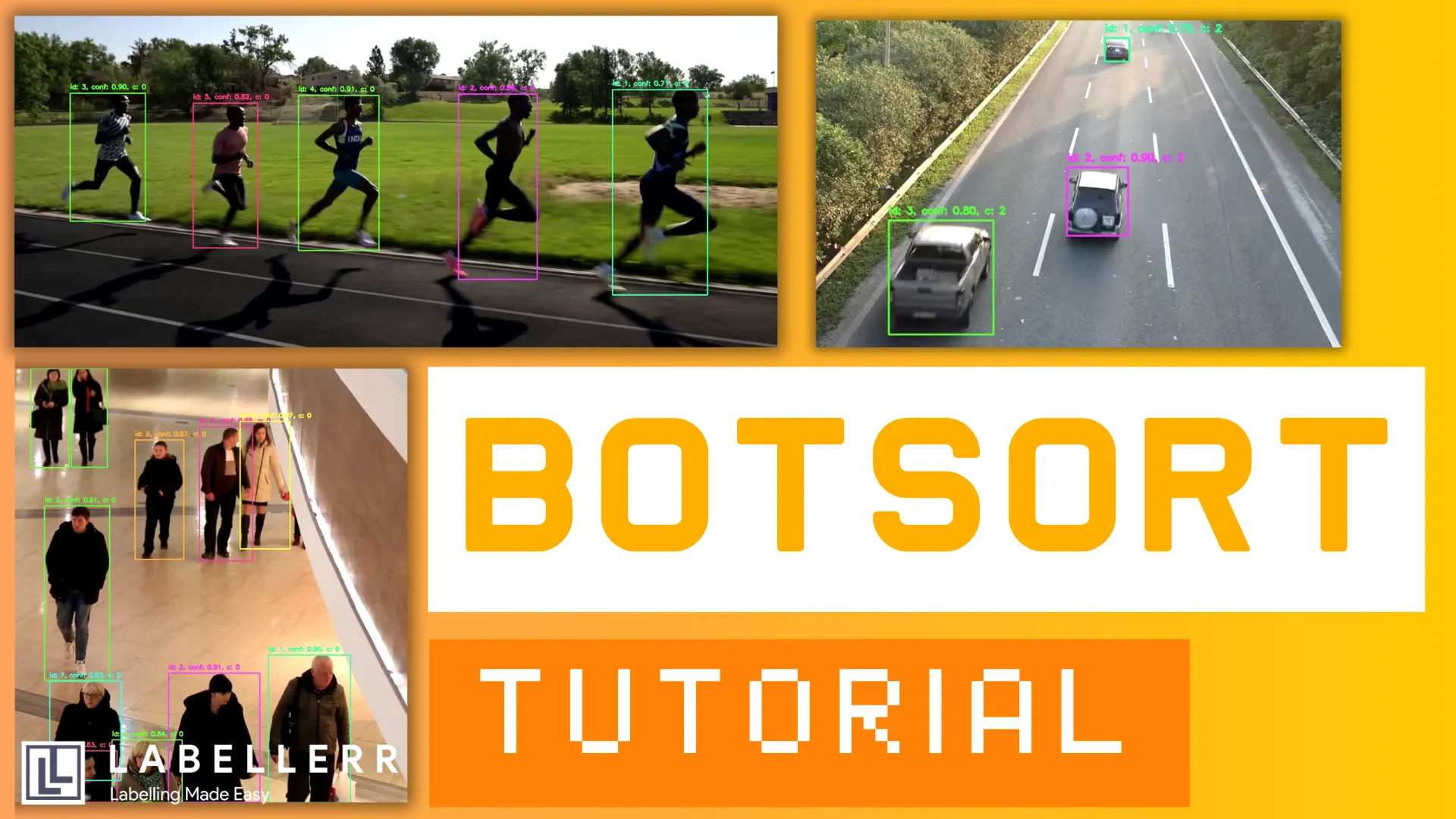Track Objects Fast: BoT-SORT + YOLO Explained!
BoT-SORT boosts multi-object tracking by refining box predictions, compensating for camera motion, and combining motion with appearance cues. Easily integrate it via Ultralytics YOLO or BoxMOT for robust tracking in crowded, dynamic scenes.

Is your current object tracking system failing you when the camera moves?
Are you losing track of multiple objects in crowded scenes, resulting in frustrating ID switches and fragmented trajectories?
If so, you're not alone in facing these persistent challenges that plague modern multi-object tracking (MOT) systems.
From autonomous vehicles navigating busy streets to surveillance systems monitoring crowded spaces, the demand for robust tracking solutions has never been higher.
However, traditional tracking methods often struggle with camera motion compensation and maintaining consistent object identities across frames, leading to suboptimal performance in real-world scenarios.
Meet BoT-SORT, a new and powerful way to solve some of the biggest problems in object tracking.
BoT-SORT uses smart tricks to track objects more accurately, even in tough situations like moving cameras or crowded scenes.
In this blog, you’ll find out how BoT-SORT solves these problems, why it’s a great tool for tracking many objects in videos, and how you can use it yourself.
What is Object Tracking?
Object tracking is a fundamental computer vision task that involves automatically identifying and following objects as they move through video sequences over time.
Unlike object detection, which only identifies objects in individual frames, tracking maintains continuity by assigning unique identities to objects and predicting their locations across consecutive frames.
The process typically begins with object detection to identify targets in the initial frame, followed by motion prediction and data association to maintain consistent tracking throughout the video sequence.
Common algorithms like SORT, DeepSORT, and ByteTrack follow this paradigm, using techniques such as Kalman filters for motion prediction and Hungarian algorithm for data association between detections and existing tracks
What is BotSORT and what is its novel approach?
BoT-SORT (Bag of Tricks for SORT) represents a significant advancement in multi-object tracking technology, developed by researchers Nir Aharon, Roy Orfaig, and Ben-Zion Bobrovsky at Tel-Aviv University.
This innovative tracker builds upon the successful ByteTrack framework while introducing three crucial improvements that address long-standing limitations in existing tracking-by-detection methods.
Problems with Previous Tracking Algorithms
- Bounding Box Prediction Was Inaccurate: Older tracking algorithms, like SORT and DeepSORT, used a Kalman filter that didn’t estimate the width and height of objects directly. Instead, they estimated things like aspect ratio, which often led to bounding boxes that didn’t fit the objects very well.
- Struggled with Moving Cameras: Most previous methods assumed the camera was still. When the camera moved (like in videos from cars or handheld devices), these trackers often lost track of objects or mixed up their identities, leading to errors.
- Trade-off Between Accuracy and Identity: Many trackers had to choose between being good at detecting objects (high MOTA score) or keeping the same ID for an object across frames (high IDF1 score), but not both at the same time.
How BoT-SORT Handles These Problems
- Better Bounding Box Prediction: BoT-SORT changes the Kalman filter to directly estimate both the width and height of objects, not just their aspect ratio. This makes the predicted boxes fit the objects much more accurately.
- Camera Motion Compensation: BoT-SORT includes a smart step that figures out how the camera has moved between frames. It adjusts the predicted positions of objects to account for this camera movement, so tracking stays accurate even if the camera is moving.
- Smart Matching of Objects: Instead of just combining motion and appearance information in a simple way, BoT-SORT uses a new method that picks the best match based on both how close objects are and how similar they look. This helps the tracker do well on both detection accuracy and keeping object identities straight.
Tracking using BotSORT
- Tracking People in a crowd
- Tracking plane
- Tracking Athlete
- Tracking car
Implementing BotSORT
- Using ultralytics
Ultralytics YOLO integrates BoT-SORT as its default tracker, making it straightforward to apply tracking to any video:
!pip install ultralytics
from ultralytics import YOLO
model = YOLO('yolo12x.pt') # or your trained model
results = model.track(source='path/to/your/video', persist=True, save=True)
This command will detect and track objects in your video, saving the output with tracked IDs
- Using PyPI - Boxmot
!pip install boxmot
Step 1: Basic BoTSORT Tracking
# Basic BoTSORT tracking with YOLO detection
!boxmot track --source your_video.mp4 --tracking-method botsort --yolo-model yolo12x.pt
Step 2: BoTSORT with ReID Model
# BoTSORT with lightweight ReID model
!boxmot track --source your_video.mp4 --tracking-method botsort --yolo-model yolo12x.pt --reid-model osnet_x0_25_market1501.pt
# BoTSORT with heavyweight ReID model for better appearance features
!boxmot track --source your_video.mp4 --tracking-method botsort --yolo-model yolo12x.pt --reid-model clip_market1501.pt
Limitations of BotSORT
BotSORT has some major limitations, just like any other tracker:
- Slower Than Some Alternatives: BoT-SORT is very accurate, but it uses more computer resources and is slower than some other trackers like ByteTrack. This means it might not be the best choice if you need very fast, real-time tracking or have limited hardware.
- Needs a Good Detector: Like most tracking-by-detection methods, BoT-SORT depends on the quality of the object detector. If the detector misses objects or makes mistakes, BoT-SORT’s tracking will also suffer.
- Can Struggle in Extreme Conditions: While BoT-SORT handles camera movement well, it can still have trouble in very challenging situations, such as when objects move very fast, look very similar, or are heavily occluded (blocked from view).
In summary, BoT-SORT is great for accuracy and handling tough tracking cases, but it is slower, depends on good detections, and can be harder to use in some situations.
Conclusion
BoT-SORT brings more reliable and accurate multi-object tracking—especially when cameras move or scenes get crowded, by improving box predictions, compensating for camera motion, and matching objects smarter.
It’s easy to use with popular tools like Ultralytics YOLO or BoxMOT, and it handles tough scenarios better than many older trackers.
Just remember it needs a strong detector, more computing power, and can slow down in extreme conditions, but for most applications, its benefits far outweigh these limits. For those interested in training robust AI models for tracking applications, our guide on AI model training provides comprehensive insights.
FAQs
1.What makes BoT-SORT different from other multi-object trackers?
BoT-SORT improves bounding-box prediction, compensates for camera motion, and uses smarter matching of motion and appearance, resulting in more accurate and stable tracking in crowded or moving-camera scenarios.
2.How can I integrate BoT-SORT into my project?
You can use BoT-SORT via Ultralytics YOLO’s built-in tracker by calling model.track(...), or install the BoxMOT package (pip install boxmot) and run boxmot track --tracking-method botsort with your YOLO and optional ReID models.
3.What are BoT-SORT’s main limitations?
BoT-SORT requires a strong object detector, uses more compute and runs slower than lightweight trackers, and can struggle under extreme occlusion, very fast motion, or when objects look nearly identical.
References

Simplify Your Data Annotation Workflow With Proven Strategies
.png)


